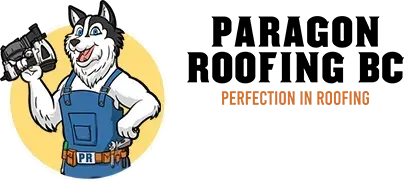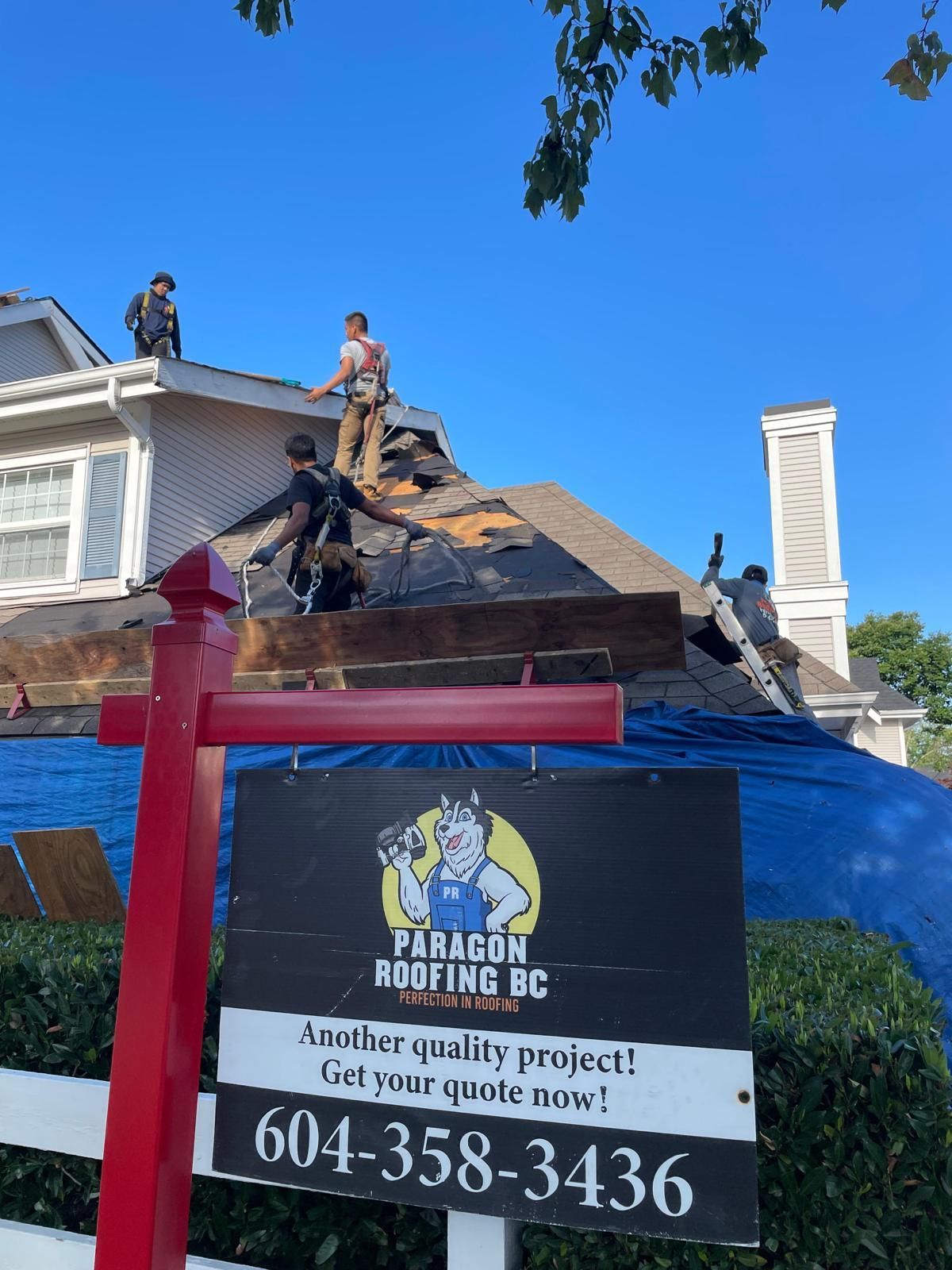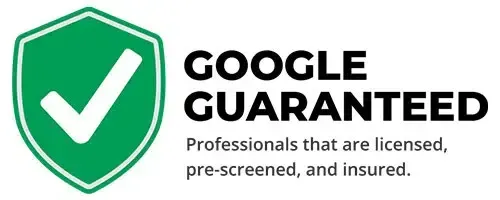Vancouver Roofing FAQ – Answers to the Most Common Questions About Your Roof
PARAGON ROOFING BC
Protecting Your Home.
Building Your Family’s Future.
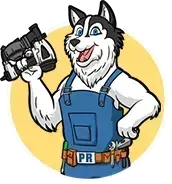
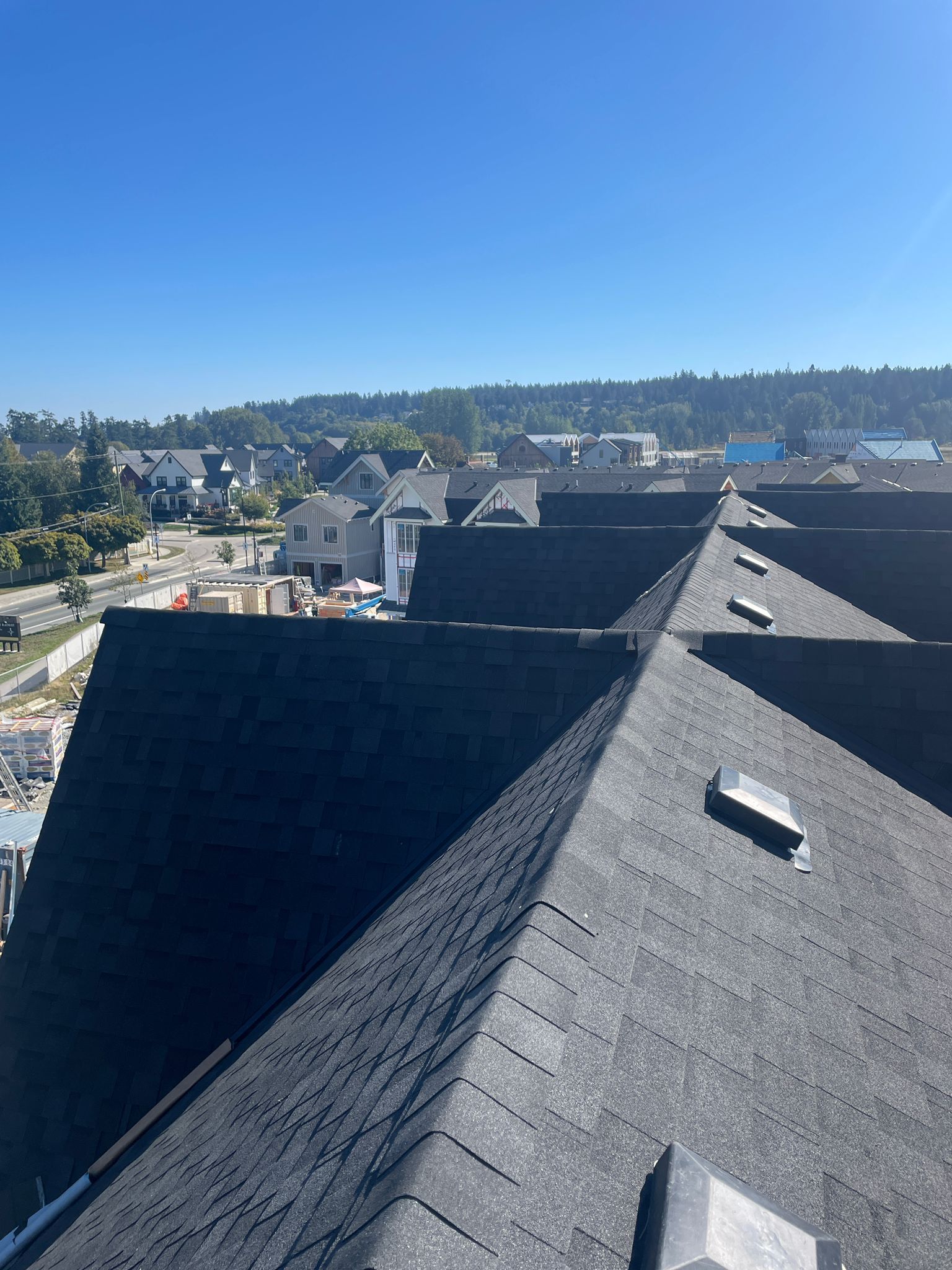
General Roofing Questions in Vancouver
How long does a roof typically last in Vancouver?
In Vancouver, roofs don’t get to live the same easy life they might in a dry, sunny climate. Here, constant rain, moisture, and shade shave years off the “brochure” lifespan. As a rough guideline:
- Asphalt shingles: usually 18–25 years in Vancouver, depending on shingle quality, installation, and maintenance. Cheap 3-tab shingles can fail closer to the low end; better architectural shingles, properly ventilated and maintained, can push further.
- Cedar shakes/shingles: typically 20–30 years if they were high-quality, properly installed, and maintained. In reality, many older cedar roofs in Vancouver are tired by their early 20s because of moss, UV, and lack of upkeep.
- Metal roofing (like standing seam): often 40–50+ years. Metal handles our rain, wind, and moss pressure far better, especially on steeper pitches and open areas where debris doesn’t sit.
- Flat roofs (torch-on, TPO, EPDM): usually 20–30 years, heavily dependent on drainage. If water ponds, that lifespan shrinks fast. If drains stay clear and details are solid, they can last much longer.
The big accelerators of aging here are moss growth, standing debris, poor ventilation, and constant wet-dry cycles. A roof that’s never cleaned, never inspected, and constantly shaded by trees will age materially faster than the exact same system on a clearer, more open lot.
How do I know if I need a roof repair or a full roof replacement?
Think of repairs as “spot fixes” and replacement as “resetting the clock.” You’re usually in repair territory when:
- The roof is still within a reasonable age range(e.g., 10–18 years for asphalt, under 20 for cedar, healthy metal or torch-on with isolated issues).
- You’re seeing isolated leaks around a chimney, skylight, or single valley.
- There are small clusters of damaged shingles, a few missing pieces, or minor flashing problems.
You start drifting into replacement territory when:
- The roof is near or beyond its expected lifespan for Vancouver conditions.
- You’re dealing with repeated leaks in different areas over a short time.
- Shingles are curled, brittle, patchy, and granules are filling your gutters.
- Cedar shakes are thin, cupped, cracked, and look more grey and stringy than solid.
- Flat roofs have wide-scale blisters, open seams, or chronic ponding that keeps causing trouble.
A good rule: if you’re chasing new leaks every season or spending money on repairs that only buy you a bit of time, it’s usually more cost-effective—and less stressful—to invest in a full replacement.
How often should I get my roof inspected in Vancouver?
In a dry climate, you might get away with “set it and forget it.” Vancouver is not that place. With our long rainy season, moss-friendly conditions, and constant moisture, inspections are more like routine health checks than a luxury.
As a guideline:
- Newer roofs (0–10 years): a check every 2–3 years is usually enough, plus any time after a major storm.
- Mid-life roofs (10–15 years): aim for every 1–2 years. This is when small issues quietly start turning into leaks if they’re ignored.
- Older roofs (15+ years for asphalt, 20+ for cedar, older flats): annual inspections are smart. At this point, you’re managing risk and planning timelines, not just checking boxes.
Material matters too. Cedar and older asphalt benefit from more frequent inspections because they’re more vulnerable to moss and UV breakdown. Flat roofs should have drains and details checked yearly minimum, since a minor blockage can cause a major leak.
What is the best time of year to replace a roof in Vancouver?
The honest answer: whenever you need it and the weather allows, but some seasons are definitely friendlier than others.
- Late spring and summer are ideal. Longer, drier days mean cleaner tear-offs, less chance of weather delays, and smoother scheduling.
- Early fall can also work well—cooler temperatures, but still enough dry windows to complete the job properly, especially for asphalt and metal.
- Winter is mostly reserved for emergency work and critical repairs. Full replacements can still be done on milder, dry stretches, but it requires tight weather watching and a flexible plan.
If you already know your roof is nearing the end, it’s better to plan a spring/summer job than wait until the first big atmospheric river hits and forces an emergency replacement under pressure. That’s when scheduling is tight, and you’re choosing from what’s available instead of having your pick.
How does Vancouver’s rainy climate affect my roof over time?
Vancouver is beautiful, but the same climate that keeps everything green is constantly testing your roof. Here’s what the weather does behind the scenes:
- Moss & algae: Shady, north-facing slopes and tree-covered homes are prime moss territory. Moss lifts shingles, traps moisture, and speeds up rot and shingle breakdown.
- Constant moisture: Roofs rarely get truly “bone dry” for long. That means materials cycle through damp and dry more often, which can speed up aging, especially on older cedar and cheaper asphalt.
- Wind-driven rain: On exposed sites—near the water, ridge tops, or tall buildings—rain doesn’t just fall straight down. It pushes sideways into flashings, wall transitions, and any weak points in the system.
- Freeze-thaw: Less dramatic than the Prairies, but still relevant. Water that sneaks into small cracks and then freezes can slowly pry things apart over time.
Because of all this, roofs in Vancouver that are ignored age much faster than roofs that are inspected, maintained, and cleaned periodically. A little proactive attention can easily add several years of healthy life to an otherwise good system.
When you’re ready for a proper evaluation—not just a quick glance from the curb—it’s worth booking a detailed check through a dedicated Vancouver roofing service like our local roofing team serving Vancouver homeowners , so you’re making decisions based on facts, not guesswork.
We're Excited To Serve YOU!
Paragon Res Roof #1
We will get back to you as soon as possible.
Please try again later.
Roof Replacement Questions
What are the main signs I need a new roof in Vancouver?
Most Vancouver roofs don’t fail all at once; they slowly “tell on themselves.” The first sign is usually age. If your asphalt shingle roof is pushing past 18–22 years in our climate, it’s officially in the “watch closely” zone, even if it isn’t pouring inside yet. Cedar in the 20–30 year range, or a flat roof over 20 years, also deserves serious attention.
Visually, look for curling, cracked, or cupped shingles, bare spots where granules have worn off, and missing shingles after wind events. On cedar, thin, brittle, or heavily split shakes are big red flags. Inside the home, water stains on ceilings or in the attic, musty smells, and visible daylight through the roof deck are warning signs you’re past basic “patch and pray” territory.
Granules piling up in gutters, chronic moss carpets that keep returning even after cleaning, and any sagging sections of roofline can all point to a system that’s not just old—it’s structurally or materially tired. One leak can sometimes be repaired; a patchwork of issues across multiple areas is usually the roof asking for full replacement.
How long does a roof replacement take?
Most single-family homes in Vancouver fall into the 1–3 day window for a full roof replacement, assuming average size and a straightforward layout. A simple gable roof with good access can sometimes be completed in a single long day with a well-organized crew. Add more roof faces, dormers, skylights, and tricky access, and you’re closer to the 2–3 day range.
Larger homes, complex designs, cedar conversions (where we’re re-sheeting with new plywood), or jobs with multiple skylights, chimneys, and detailed flashing work can stretch beyond that. Weather is another variable—if we’re dodging showers or working around Vancouver’s moody forecast, we may stage the job in sections to keep everything watertight, which can extend the calendar time without actually increasing the total labour hours too much.
What you should expect from a good installer is clear communication: a projected start date, estimated duration, how they’ll handle bad weather, and a daily game plan so you’re not guessing what’s happening on your own roof.
Do I have to move out while my roof is being replaced?
In almost all cases, no—you can stay in your home during a roof replacement. There’s no need to pack up and move unless you personally prefer to avoid the noise. The work is loud (hammering, compressors, footsteps) and you’ll feel some vibration, especially on upper floors, but it’s temporary and contained to daytime hours.
Pets and kids are the main consideration. Some dogs find the noise and vibration stressful; cats may disappear under beds for the duration. If you work from home and are sensitive to sound, you might want to plan a day or two at a café, co-working space, or a quieter room away from the main impact zone.
The bigger safety rule is outside, not inside: everyone should stay clear of the perimeter while crews are working overhead. Roofers should cone off danger zones, manage debris carefully, and do magnet sweeps to pick up nails at the end of each day. Inside your home, life generally continues as normal—just with a soundtrack of renovation for a short stretch.
What is included in a full roof replacement?
A true roof replacement is far more than “new shingles on top of old ones.” It starts with a full tear-off of the existing roofing material—shingles, cedar, underlayment, old flashings—down to the roof deck. From there, the deck is inspected for rot, soft spots, and damage; any compromised plywood is replaced so the new system isn’t being installed over a weak base.
Then comes the underlayment and waterproofing layer: synthetic underlayment across the deck, with higher-protection membranes (like ice & water) in vulnerable areas such as valleys, eaves, skylights, chimneys, and wall transitions. Only after the foundation is solid do we install the new main roof system—whether that’s asphalt shingles, metal, synthetic shake/slate, or another approved material—following manufacturer specs and local best practices for nailing patterns, overlaps, and details.
A proper replacement also includes new flashings(step flashings, chimney flashings, drip edge, pipe boots), appropriate ventilation components, and any necessary adjustments to vents or exhausts. Finally, there’s cleanup and final inspection: debris removal, magnet sweeps for nails, and a walkthrough so you understand what was done and what warranties now protect your home.
Should I replace gutters at the same time as my roof?
You don’t have to replace gutters every time you replace a roof—but it’s often the best moment to decide. If your gutters are old, leaking at seams, poorly sloped, or constantly overflowing, pairing a roof replacement with new gutters can solve multiple problems in one coordinated project. The fascia interface, drip edge, and gutter hangers all work together, so doing them at the same time can give you a cleaner, more watertight result.
It also reduces duplicated labour. When a roofing crew is already setting up ladders, protection, and access around your home, swapping gutters in the same window is usually more efficient than calling someone back months later to disturb the perimeter again.
On the other hand, if your gutters are relatively new, properly sized, and working well, a reputable contractor will tell you they can stay. The key is an honest assessment and a plan that looks at the roof and drainage as one system. If you’re unsure, this is exactly the type of conversation we have with homeowners when they inquire about Vancouver roof replacement services through our dedicated page for complete roof replacement in Vancouver’s climate.
Roof Repair & Leak Questions
My roof is leaking – what should I do first?
First thing: don’t panic, but don’t ignore it either. A leak almost never gets better on its own. Start by protecting the inside of your home. Move furniture, electronics, and anything absorbent out from under the drip. Put a bucket or container under the leak and lay down towels or plastic to catch splashes and prevent floor damage. If water is coming through a light fixture or electrical area, turn off power to that circuit at the panel and stay clear.
Next, document what you’re seeing. Take quick photos or a short video of the leak, ceiling stains, and any visible damage. This helps with both the roofer’s diagnosis and any future insurance conversations. What you don’t want to do is climb onto a wet, slippery Vancouver roof in the rain to “take a look” – that’s how people get seriously hurt, and it usually doesn’t fix anything.
It’s also important to understand that the spot where water shows up inside is often not the exact spot where it enters the roof. Water can travel along rafters, vapour barriers, and framing from valleys, chimneys, skylights, plumbing vents, or wall intersections before finally dripping into your living room. Once you’ve contained the damage as best you can, your next move is to call a roofing contractor who handles emergency leak response and proper roof repair services in Vancouver, such as a team that specializes in finding and fixing leaks on Vancouver homes.
Can you repair a leaky roof during the rain in Vancouver?
Short answer: we can almost always stabilize it, but permanent repairs usually need at least a short dry window. Working on a soaked roof under active rainfall is a safety issue first and a quality issue second. Torching membranes, applying adhesives, or installing shingles on a saturated surface means those materials may not bond properly—and you’ll just end up paying twice.
That’s where emergency measures come in. In the middle of a storm, the priority is to stop or slow the water: tarps, temporary peel-and-stick membranes, temporary tie-ins around vents or chimneys, and clearing blocked drains or gutters if they’re contributing to the leak. These are “get you through the storm” tactics, not the final solution.
Once the weather gives even a small break, a proper crew can open up suspect areas, dry things out, replace damaged materials, and install long-term fixes. In a city that sees atmospheric rivers and long, grey stretches, good roofers build their processes around working in tight weather windows—stabilize in the rain, fix properly when it’s safe and dry enough to do so.
When is a repair enough and when is replacement a better idea?
Think of a roof like a car engine. If one hose cracks, you replace the hose. If every hose, belt, and seal is failing, you stop throwing parts at it and rebuild or replace. A targeted repair makes sense when the roof is still within a reasonable age range, the issue is localized (for example, a bad flashing detail or a small section of blown-off shingles), and the rest of the system still looks healthy.
A replacement starts to make more sense when:
- The roof is at or beyond its expected lifespan in Vancouver’s climate
- You’re seeing repeated leaks in different areas
- Shingles or shakes are deteriorated across large sections, not just at one weak spot
- Previous patch jobs are layered over each other and nothing feels “solid” anymore
There’s also a cost threshold. If you’re pouring money into repairs every rainy season—5 leaks one year, 3 the next, another 4 the year after—you’re essentially drip-feeding a roof that’s trying to retire. At some point, the cumulative repair cost + stress + risk of interior damage outweighs biting the bullet and installing a new system that you don’t have to worry about every time the forecast turns ugly.
How quickly can you respond to an emergency roof leak?
In a perfect world, the answer would always be “immediately.” In the real world, response time depends on how slammed roofers are—especially during big storm cycles when half the city seems to start dripping at once. A good company will triage leaks, prioritizing active interior water intrusion over minor, non-urgent issues.
In general, you can expect something like:
- Same-day or next-day response for serious, active leaks affecting living spaces, especially during business hours
- Slightly longer waits during major storm events, with honest updates about where you are in the queue
- An initial visit focused on stopping the immediate damage(tarping or temporary repairs), then a follow-up appointment for permanent repairs once conditions and scheduling allow
What matters most is that you’re not ignored, you’re given realistic expectations, and the roofer communicates clearly: when they can arrive, what they’ll do first, and how they’ll move from emergency stop-gap to durable fix.
Will a small repair void my existing roof warranty?
This is where warranty fine print and real-world practice intersect. Most roofs have two layers of protection:
- A manufacturer’s warranty on the shingles/metal/membrane
- A workmanship or labour warranty from the installer
A properly done small repair—using compatible materials and correct methods—usually does not automatically void a manufacturer’s warranty. The bigger risk is when someone unqualified cuts corners: wrong sealants, improper fasteners, sloppy flashing work, or damage to the surrounding shingles while “repairing” a small area. If the manufacturer can connect a failure to improper work, they may decline coverage on that specific issue.
On the workmanship side, if your roof is still under labour warranty from the original installer, it’s smart to call them first. Many labour warranties require that the original contractor be given the chance to address issues before anyone else touches the roof. Bringing in another company without letting the original roofer see the problem can, in some cases, complicate that coverage.
Best practice:
- Keep records and photos of any repairs
- Ask the roofer to explain what they’re doing and why
- Save invoices in case you need to show that repairs were done professionally
A small, well-documented repair by a reputable contractor is very unlikely to “blow up” your entire roof warranty—but sloppy, undocumented patch jobs absolutely can come back to haunt you.
Roofing Costs & Estimates in Vancouver
How much does a new roof cost in Vancouver?
A new roof in Vancouver isn’t a one-size-fits-all price tag; it’s a spectrum. A small, simple bungalow with a straightforward asphalt shingle roof will sit at the lower end of that range, while a large, steep, cut-up roof with lots of hips, valleys, skylights, and chimneys can move you into the higher tiers very quickly.
Material is the next big driver. Asphalt shingles sit in the “most budget-friendly” category. Architectural/synthetic shingles and synthetic shake/slate push into the mid–upper range. Metal roofing(like standing seam) and high-end composites often sit at the premium end, especially on complex roofs.
On top of that, you’ve got the hidden line items most homeowners don’t see at first glance:
- Plywood replacement (especially after cedar tear-offs)
- Proper underlayment, ice & water membranes, and ventilation upgrades
- Flashings around chimneys, skylights, and walls
- Site protection, disposal, and clean-up
So instead of a single “Vancouver roof price,” think of it as: house size + roof complexity + chosen material + required upgrades. That’s the formula that determines where your project lands on the overall cost curve.
Why do roofing quotes vary so much between contractors?
If you’ve ever gathered three or four quotes and wondered whether these companies even looked at the same roof, you’re not alone. Big gaps usually come down to four things: materials, scope, protection, and business practices.
Some contractors will quote entry-level shingles, minimal underlayment, and basic flashings—while others specify premium shingles, full synthetic underlay, ice & water in critical areas, upgraded vents, and custom metal flashings. On paper both are “roof replacements,” but they’re very different roofs in terms of performance and lifespan.
Scope is another big one. One quote might include:
- Plywood replacement allowances
- Proper ventilation upgrades
- New flashings, vents, pipe boots
- Full clean-up and disposal
…while another quietly assumes “no rotten wood, reuse most flashings, minimal vent work.” Naturally, the second one looks cheaper—until the surprises start.
Then there’s the business side. Proper liability insurance, WCB coverage, trained crews, safety compliance, and project management all cost money—but they also protect you. A very low quote can sometimes mean corners are being cut in places you can’t see: safety, training, supervision, or warranty backing.
What information do you need to provide an accurate roofing estimate?
The more detail you share up front, the more accurate and realistic your estimate will be. At minimum, a roofing company will want:
- Your address – So they can check access, roof shape, and neighbourhood via maps or a drive-by.
- Photos – Wide shots of the whole house plus close-ups of problem areas (valleys, chimneys, skylights, mossy sections).
- Roof age & material – Approximate age, brand if you know it, and whether it’s asphalt, cedar, metal, or flat roofing.
- Known issues – Leaks, ceiling stains, soft spots, moss, past repairs, or any “mystery” areas that worry you.
- Attic access(if possible) – Knowing whether there are ventilation, condensation, or insulation issues can change the recommended scope.
For a rough ballpark, photos and basic info are often enough. For a proper, locked-in quote, a site visit is usually essential—measuring the roof, checking slopes, seeing the flashings up close, and getting a sense of how much plywood or structural work might be needed.
Do you offer financing or staged payments for roof projects?
Most homeowners don’t have a full roof replacement just sitting in a separate “roof fund,” so it’s completely normal to ask how payments work. In Vancouver, a typical structure might look like:
- Deposit / booking payment – To lock in your spot in the schedule and secure materials.
- Progress payment(s) – Often after tear-off and inspection, or after a specific percentage of work is complete.
- Final payment – Once the roof is finished, site is cleaned, and you’ve had a walkthrough or final check.
On top of staged payments, some companies offer dedicated roof financing for larger projects—especially when a roof fails earlier than expected or an inspection or insurance requirement forces a replacement sooner than planned. If you’re looking to spread out the cost of a Vancouver roof replacement, it’s worth exploring dedicated roof financing options instead of putting everything on high-interest credit.
Is the cheapest quote always the best value?
Almost never. The cheapest quote can sometimes work out—but only if the scope, materials, and protections are truly comparable. In reality, the lowest bid is often created by trimming things you can’t see: thinner underlayment, fewer ventilation upgrades, minimal flashing work, tiny or zero plywood allowance, unskilled labour, or almost no contingency for surprises.
A good quote doesn’t aim to be the cheapest; it aims to be complete and honest. It spells out what happens if rotten wood is found, what materials are being used, how valves, chimneys, skylights, and wall transitions are handled, and how long the contractor will stand behind their work.
When you compare quotes, don’t just look at the final number. Look at:
- What exactly is included and excluded
- The quality and brand of materials
- The approach to ventilation, flashing, and waterproofing
- Warranty strength and who is actually honouring it
- Reviews, past projects, and how they communicate with you
In a rainy city like Vancouver, a roof that’s “cheap but compromised” can turn into interior damage, mold, repeated repairs, and an earlier re-roof. The best value is almost always the roof that’s done properly once —not the one that wins a race to the bottom on price.
Roofing Materials – Vancouver Homeowner Questions
What roofing materials work best in Vancouver’s climate?
Vancouver’s roofs live in a different world than dry inland cities. You’ve got year-round moisture, long stretches of drizzle, occasional snow, and lots of shade from mature trees. That combo is brutal on anything that holds water, traps debris, or doesn’t shed rain quickly.
For most homes, architectural asphalt shingles, standing seam or other quality metal roofing, and premium synthetics(like composite shakes or slate-look products) tend to perform best. Asphalt is the “workhorse” option: cost-effective, flexible for most neighbourhoods, and proven in our coastal rain. Metal shines (literally and figuratively) on modern or higher-end homes where long life, clean lines, and low moss growth matter. Synthetics sit in the “best of both worlds” lane—cedar or slate aesthetics without nearly as much maintenance or rot risk.
If your home is older or in a heavily treed area, your roof will be dealing with constant shade, dripping branches, and slower drying times. That’s where material choice really matters. Anything that dries fast, resists moss, and holds its granules or coatings tends to win in the long run. If you want to see how these options stack up side by side, our guide to roofing materials in Vancouver walks through the trade-offs in more detail.
Are metal roofs noisy when it rains?
Short answer: not when they’re installed properly. The “loud tin roof” idea comes from barns, carports, and uninsulated sheds—thin metal panels directly over open framing. A typical Vancouver home is completely different.
On a residential install, you’ve got:
- Roof deck (plywood)
- Underlayment and sometimes sound-dampening layers
- Insulation and drywall below
Rain hits the metal panel, the energy spreads, and those layers soak up most of the sound. Inside the home, you usually hear less rain noise with quality metal than with a thin old cedar shake roof over poor insulation.
If you’re particularly sound-sensitive, mention it during planning—panel profile, underlayment choice, and attic insulation can all be tweaked to keep things extra quiet.
Is cedar roofing still a good idea in Vancouver?
Cedar can still be beautiful here, but it’s no longer the default “no-brainer” it was in the 80s and 90s. Our wet, mossy climate plus modern forestry practices means many cedar roofs don’t live as long as people expect unless they’re maintained aggressively.
Pros:
- Gorgeous, natural aesthetic
- Suits character homes, West Coast architecture, and higher-end neighbourhoods
- Good insulative properties
Cons in Vancouver:
- Moss loves cedar —the texture and constant moisture are perfect for growth
- Needs periodic cleaning and treatment if you want to hit the upper end of its lifespan
- Many insurers are less excited about old cedar; some flag it as a risk after a certain age
If you already have cedar and it’s aging out, it’s often smarter to convert to asphalt, synthetic shake, or metal instead of putting new cedar on again, especially if you’re tired of moss bills.
What are synthetic roofing products like Enviroshake, and are they worth it?
Synthetic shake and slate products—like Enviroshake and other composite systems—are designed to mimic the look of cedar or natural slate while solving most of the problems that come with them. Think of them as engineered roofing: consistent, predictable, and built to stand up to moisture and UV better than raw wood.
Why homeowners like them in Vancouver:
- Cedar look without constant moss treatments
- Strong impact resistance for branches and wind-driven debris
- Colour stability is better than natural wood graying out unevenly
- Long lifespans with relatively low maintenance
They usually cost more upfront than asphalt shingles, often similar to or a bit less than many high-end metal or slate options. They make the most sense if you have a higher-value property, a strong aesthetic standard in your neighbourhood, or you simply want the cedar/slate vibe without the constant “is my roof rotting?” anxiety.
What’s the difference between 3-tab and architectural shingles?
3-tab shingles are the older, flat, single-layer style you see on a lot of older roofs. Architectural (or laminated) shingles are thicker, layered, and dimensional —they look more like small shakes and have better wind ratings and longer lifespans.
Key differences:
- Appearance: Architectural shingles have depth and shadow lines; 3-tab looks flat.
- Lifespan: Architectural typically outlasts 3-tab when both are installed correctly.
- Wind performance: Architectural shingles usually carry higher wind ratings, which matters with our coastal gusts.
- Cost: 3-tab is cheaper upfront but rarely the better long-term value in Vancouver’s climate.
If you’re re-roofing, architectural is almost always the smarter play for durability, resale, and curb appeal.
Flat Roofing & Torch-On Questions
What’s the best roofing system for a flat roof in Vancouver?
Flat and low-slope roofs are all about drainage and seam integrity. In Vancouver’s rain, that usually points to three main systems: torch-on (SBS), TPO, and EPDM.
- Torch-on (SBS): A multi-layer asphalt-based membrane applied with heat. Great for small commercial buildings, garages, additions, and strata carports. Proven, repairable, and widely used locally.
- TPO: A single-ply, heat-welded white membrane. Often chosen for bigger commercial roofs or where energy efficiency and reflectivity are priorities.
- EPDM: A rubber sheet membrane, very durable and flexible, popular for larger footprints and industrial applications.
“Best” depends on roof size, how complex the detailing is, access, and your budget. For many smaller residential and strata flats, torch-on is still the workhorse because it balances cost, performance, and ease of repair.
How long does a flat roof last?
In Vancouver, you’re typically looking at:
- Torch-on (SBS): around 20–25 years when properly installed and maintained
- TPO: roughly 20–30 years depending on thickness, colour, and exposure
- EPDM: often 25–30 years when looked after
Those are not promises—they’re realistic ranges if the slope, drains, and detailing are done right and you keep drains clear. A neglected flat roof with ponding water and clogged drains can be in serious trouble well before it “should” be.
Why do flat roofs leak so often?
Most flat roof leaks are not about the membrane failing randomly. They’re about:
- Water sitting too long (ponding) because of poor slope
- Blocked drains and scuppers
- Bad detailing at parapet walls, skylights, HVAC equipment, and transitions
- Old, poorly fused seams or patchwork repairs over many years
Because flat roofs don’t shed water quickly like steep shingles, any weakness becomes a slow, persistent leak path. On the inside, that leak often shows up far away from the actual entry point, which is why these roofs can be tricky to diagnose.
What is torch-on roofing, and is it safe?
Torch-on roofing uses SBS-modified bitumen membranes heated with a torch to bond them to the substrate and to each other. The system is usually at least two layers (base sheet + cap sheet), giving you a thick, layered waterproofing blanket.
Is it safe? When it’s done by trained crews with proper fire watches, extinguishers, and good housekeeping, yes. The risk comes when inexperienced installers cut corners—torching too hot, working around debris, or not following fire safety procedures. On properly run jobs, a controlled, methodical approach makes torch-on a very reliable option for Vancouver flat roofs.
How often should drains and scuppers be checked on a flat roof?
In a rainy, tree-heavy city like Vancouver, you don’t get to ignore drains. At minimum:
- Twice a year: fall (after leaves drop) and spring
- After big windstorms: to clear branches and debris
- Any time you notice standing water: longer than 48 hours after rain stops
Clogged drains are one of the fastest ways to turn a healthy membrane into a leaking mess. Quick visual checks and clearing debris are cheap insurance compared to tearing open ceilings later.
Ventilation, Insulation & Attic Questions
Why does roof ventilation matter in Vancouver’s climate?
Because our roofs don’t just deal with rain from the outside—they deal with moist air from inside the home trying to escape upward. In a damp climate, that combination can lead to condensation on the underside of the roof deck if the attic doesn’t breathe properly.
Good ventilation helps:
- Carry moisture out before it condenses
- Keep attic temperatures more even
- Protect shingles and underlayment from baking on hot days
- Reduce the risk of mold and musty odors
In Vancouver, where winter air is cool and moist and homes are heated from inside, ventilation is non-negotiable if you want your roof system to actually reach its intended lifespan.
How do I know if my attic is properly ventilated?
Some of the signs you don’t have proper ventilation:
- Frost or condensation on the underside of the roof deck in winter
- Musty smells in the attic
- Dark staining around nails on the underside of sheathing
- Mold on the underside of the roof deck or on insulation
- Extremely hot attic in summer
A balanced system usually includes intake(soffit vents) and exhaust(ridge vents, roof vents, or a combination). A proper inspection means getting into the attic, not just guessing from the street.
Can poor attic insulation cause roof problems?
Yes. Insulation and ventilation are tied at the hip. Poor or patchy insulation can let too much heat escape into the attic in winter, warming the roof deck and causing snow melt. On certain roof designs, that can lead to ice-related issues and more cycling of freeze/thaw at the eaves.
On the flip side, if warm, moist household air meets a cold roof deck because insulation is weak or poorly installed, you can see condensation and, over time, mold or rot. So while insulation is often thought of as an “energy bill” issue, in Vancouver it’s also a roof health issue.
Should I upgrade my insulation when I replace my roof?
Often, yes—especially if your roof is already opened up, or you have easy access from the attic side. Roof replacement is a natural time to:
- Add insulation where levels are low
- Pull back insulation that’s blocking soffit vents
- Fix air leaks (around pot lights, chimneys, hatches) that drive warm moist air into the attic
Every house is different, but if your attic feels like a freezer in winter and a sauna in summer, pairing a new roof with insulation and ventilation upgrades is almost always money well spent.
Vancouver-Specific Roofing Questions
Why is moss such a big problem on Vancouver roofs?
Moss loves three things: shade, moisture, and rough surfaces. Vancouver has all three in abundance—tall trees, constant drizzle, and older roofs with textured shingles or cedar. North-facing slopes and roofs under big evergreens barely dry out for months.
Moss doesn’t just sit there looking fuzzy; it slowly lifts shingles, traps water, and accelerates the breakdown of roofing materials. Left alone, it shortens roof life and sets you up for leaks, especially around valleys and lower slopes.
How often should I have moss removed from my roof?
There’s no one-size answer, but a good rule of thumb in Vancouver is:
- Light moss areas: every 3–5 years with gentle cleaning and treatment
- Heavy tree cover / north-facing slopes: every 1–2 years, or as soon as moss starts to establish
The key is to catch it early and avoid harsh methods like aggressive pressure washing that strip granules or damage shingles. A gentle, roof-safe program beats “ignore it for 10 years, then panic and blast it” every time.
Is pressure washing my roof a good idea?
For almost all shingle and cedar roofs, the answer is no. High-pressure washing can:
- Strip off protective granules on asphalt shingles
- Tear fibres and accelerate decay on cedar
- Force water up under laps and into the roof system
Safer approaches use low-pressure rinsing, soft brushing, and appropriate cleaning solutions designed for roofing materials. The goal is to preserve the roof while removing growth—not to make it look like brand-new concrete at the expense of its lifespan.
Do you work in all Vancouver neighbourhoods?
Most serious roofing companies that focus on Vancouver will cover the full city: East Van, Kitsilano, Dunbar, Kerrisdale, Main Street, Grandview-Woodland, the West End, West Point Grey, and everything in between. The challenges are slightly different—big trees in some areas, ocean exposure in others—but the core approach is the same: pick the right system for the micro-climate and install it properly.
If you’re not sure whether your area is covered, just ask for a quick yes/no with your street name. It’s usually easier than you think to get a crew out for an inspection or quote.
How does being near the ocean affect my roof?
Living near the water brings salt, higher wind exposure, and harsher conditions on certain days. That can mean:
- More wear on metal components if the wrong coatings are used
- Stronger wind loads on edges and ridges
- More driven rain against walls and tricky roof transitions
It doesn’t mean you can’t have a long-lasting roof—it just means material choice and detailing matter more. High-quality metal with proper coatings, well-flashed transitions, securely fastened shingles, and good ventilation will always outperform cheap, bare-minimum installs in coastal pockets of the city.
Let's Chat Roofing!
Paragon Res Roof #2
We will get back to you as soon as possible.
Please try again later.
Where We Go.
Proudly serving our local community & focused on being the best Vancouver roofers possible.
Vancouver
Acadia Park, Arbutus Ridge, Burrard Indian Reserve, Cambie, Capilano Indian Reserve 5, Cedar Cottage, Champlain Heights, Chinatown, Coal Harbour, Collingwood, Commercial Drive, Creekside, Davie Village, Downtown, Downtown Eastside, Downtown South, Downtown Vancouver, Dunbar Southlands, East Hastings, English Bay, Fairview, False Creek Flats, False Creek North, False Creek South, Fraser, Fraserview, Gastown, Grandview - Woodland, Granville, Granville Entertainment District, Granville Island, Greektown, Hastings - Sunrise, Hastings Crossing, Hastings East, Hillcrest, Historic Japan Town, Hogans Alley, Kensington - Cedar Cottage, Kerrisdale, Killarney, Kits Point, Kitsilano, Knight, Langara, Little Ginza, Little India, Little Mountain, Lost Lagoon, Lower Hudson, MacKenzie Heights, Main, Marpole, Metro Vancouver, McMillan Island 6, Mole Hill, Mount Pleasant, Mt. Pleasant, Musqueam, Musqueam Indian Reserve 2, Norquay Village, North Vancouver, Oak, Oakridge, Olympic Village, Quilchena, Renfrew - Collingwood, Renfrew Heights, Riley Park, Seymour Creek Indian Reserve, Shaughnessy, Shaughnessy Heights, South Cambie, South False Creek, South Granville, South Hill, South Vancouver, Southlands, Southwest Marine, Stanley Park, Stanley Park Subdivision, Strathcona, Sunrise, Sunset, The Drive, Tsawwassen Indian Reserve, University Endowment Lands, University Hill, Victoria - Fraserview, West Broadway, West End, West Point Grey, West Vancouver, Westbrook Village, White Rock, Woodland, Yaletown - Stadium District
West Vancouver
Altamont, Ambleside, Ambleside Beach, Bayridge, British Properties, Cammeray, Canerbury, Caulfeild, Cedardale, Chartwell, Chelsea Park, Cypress, Cypress Bowl, Cypress Park, Cypress Park Estates, Deer Ridge, Dundarave, Dundarave Village, Eagle Harbour, Eagle Ridge, Furry Creek, Gleneagles, Glenmore, Horseshoe Bay, Howe Sound, Lions Bay, Olde Caulfeild, Panorama, Panorama Village, Park Royal, Porteau Cove, Queens, Rockridge, Sandy Cove, Sentinel Hill, Sunset Beach, Upper Caulfeild, Upper Levels Highway, Wentworth, West Bay, Westhill, Westmount, Whitby Estates, Whytecliff
North Vancouver
Blueridge, Boundary, Braemar, Canyon Heights, Capilano, Carisbrooke, Cedar Village, Central Lonsdale, Central Lynn, Cleveland, Cove Cliff, Deep Cove, Delbrook, Dollarton, Edgemont Village, Grand Boulevard, Grouse Woods, Handsworth, Highlands, Indian River, Keith Lynn, Kirkstone, Lions Gate, Lower Capilano, Lower Capilano Marine, Lower Lonsdale, Lower West Lynn, Lynn Canyon, Lynn Creek, Lynn Valley, Lynn Valley Centre, Lynnmour North, Lynnmour South, Mahon, Main Street, Maplewood, Marine-Hamilton, McCartney Woods, Mission IR#1, Moodyville, Norgate, Northlands, Norwood Queens, Parkgate, Parkway, Pemberton Heights, Riverside East, Riverside West, Roche Point, Seymour Heights, Tempe, Upper Capilano, Upper Delbrook, Upper Lonsdale, Upper Lynn, Upper West Lynn, West Lynn Terrace, Westview, Windridge, Windsor Park
Port Moody
April Road, Barber Street, Belcara, College Park, Coronation Park, Glenayre, Harbor Heights, Heritage Mountain, Heritage Woods, Inlet Centre, Ioco, Moody Centre, Mountain Meadows, Noons Creek, North Shore, Pleasantside, Port Moody Centre, Seaview, Twin Creeks
Lions Bay
Alberta Bay, Kelvin Grove, Brunswick Beach, Oceanview Road, Panorama Road, Bayview, Sunset Drive, Stewart Road
Pitt Meadows
Central Pitt Meadows, North Pitt Meadows, Pitt Meadows City Centre, Pitt Polder, West Pitt Meadows
Bowen Island
Apodaca Park, Arbutus Point, Artisan Square, Bluewater, Bowen Bay, Cates Hill, Collins Road, Cove Bay, Cowan Point, Davies Orchard, Deep Bay, Eagle Cliff, Fairweather, Fairweather Point, Galbraith Bay, Grafton Bay, Hood Point, Hood Point West, Josephine Lake, King Edward Bay, Miller's Landing, Mount Gardner, Mt Gardner, Ocean view, Queen Charlotte Heights, Scarborough, Sealeigh Park, Seven Hills, Seymour Bay/Alder Cove, Snug Cove, Snug Point, Sunset Park, Sunset Park Estates, The Cape, The Holdings, The Valley, Timber Grove, Tunstall Bay, Union Bay, Valhalla, Village Square
Delta
Annieville, Beach Grove, Boundary Beach, Cliff Drive, Delta Manor, East Delta, English Bluff, Hawthorne, Holly, Ladner, Neilson Grove, Nordel, Pebble Hill, Port Guichon, Scottsdale, Sunshine Hills, Tsawwassen Central, Tsawwassen East, Tsawwassen North, Annacis Island, Ladner Village, Holly Park, Ladner Rural, Westham Island, Ladner Central, Marina Garden Estates, Canoe Pass Village, Country Woods, Elliot, Riverside Industrial Park, Whitelaw, Mountain View, Tilbury Industrial Park, Tilbury North, Tilbury East, Westridge Industrial Park, Delta Heritage Airpark, Delta Port Industrial Park, Tilbury Business Park, West Ladner Industrial Park, Tilbury Auto Mall, Tsawwassen Heights, Boundary Bay, Tsawwassen Shores, Annacis Island Industrial Park, Kennedy, Sunshine Woods, The Highlands, Imperial Village, Forest-by-the-Bay, Sunbury
Belcarra
Belcarra Village, Belcarra Bay, Bedwell Bay, Coombe, Cosy Cove, Woodhaven, Belvedere, Twin Islands
Surrey
Alluvia, Aloha Estates, Amble Green, Anniedale - Tynehead, Bear Creek Green Timbers, Campbell Heights, Clayton, Cloverdale, Cloverdale Town Centre, Crescent Beach, Crescent Beach – Ocean Park, Douglas, East Clayton, East Clayton North, East Clayton West, East Newton, East Newton North, East Newton South, East Panorama Ridge, Elgin, Elgin - Chantrell, Elgin Chantrell, Fleetwood, Fleetwood Enclave, Fleetwood Town Centre, Fraser Heights, Grandview Heights, Guildford, Guildford Town Centre, Highway 99 Corridor, King George Corridor, Morgan Creek, Morgan Heights, Mud Bay, Newton, Newton Town Centre, North Cloverdale East, North Cloverdale West, North Grandview Heights, North Surrey, Ocean Park, Orchard Grove, Panorama Ridge, Queen Mary Park, Rosemary Heights Central, Rosemary Heights West, Saint Helen’s Park, Semiahmoo Town Centre, South Newton, South Port Kells, South Surrey, South Westminster, South Westminster Heights, Sullivan, Sunnyside Heights, Surrey Metro Centre, Surrey Newton, West Clayton, West Cloverdale North, West Cloverdale South, West Newton, West Newton - Highway 10, West Newton North, West Newton South, Whalley
Richmond
Aberdeen Village, Acheson-Bennett, Ash Street, Boyd Park, Boyde Park, Brideport Village, Bridgeport, Brighouse, Brighouse South, Brighouse Village, British Columbia Packers, Broadmoor, Capstan Village, Central West, Dover Crossing, East Cambie, East Livingstone, East Richmond, Garden City, Gilmore, Golden Village, Granville, Hamilton, Historic Steveston Village, Ironwood, Lackner, Lansdowne Village, Laurelwood, London - Princess, McLennan, McLennan North, McLennan South, McNair, Mitchell Island, Moffatt, North Granville, Oval Village, Quilchena, Riverdale, Saunders, Sea Island, Seafair, South Arm, St Albans, Steveston North, Steveston South, Steveston Village, Sunnymeade North, Terra Nova, West Cambie, Westwind, Woodwards
Burnaby
Ardingley-Sprott, Big Bend, Brentwood, Brentwood Park, Buckingham Heights, Burnaby Heights, Burnaby Lake, Capitol Hill, Cariboo, Cariboo-Armstrong, Cascade-Schou, Central Burnaby, Central Park, Clinton-Glenwood, Deer Lake, Deer Lake Place, Douglas-Gilpin, East Burnaby, Edmonds, Englewood Mews, Forest Glen, Forest Hills, Garden Village, Government Road, Highgate, Kingsway-Beresford, Lake City, Lakeview-Mayfield, Lochdale, Lougheed, Lyndhurst, Marlborough, Maywood, Metrotown, Montecito, Morley-Buckingham, North Burnaby, Oakalla, Oaklands, Parkcrest, Parkcrest-Aubrey, Richmond Park, Second Street, Simon Fraser Hills, Simon Fraser University, South Burnaby, South Slope, Sperling-Broadway, Sperling-Duthie, Stride Avenue, Stride Hill, Sullivan Heights, Suncrest, Sussex-Nelson, The Crest, Upper Deer Lake, Vancouver Heights, West Central Valley, Westridge, Willingdon Heights, Windsor
Langley & Langley Township
Aldergrove, Alice Brown, Anderson Creek, Bedford Landing, Belair Estates, Bell Park, Blacklock, Brookswood, Brookswood Homes, Brookswood-Fernridge, Campbell Valley, Campvell Valley, Carvolt, Carvolth, Cedar Ridge, Cedar Ridge Estates, Civic Center District, Country Line Glen Valley, Country Woods, County Line Glen Valley, Derby Hills, Douglas, Downtown Langley, Eaglecrest, East Brookwood, Entertainment District, Fairview Estates, Fern Ridge, Fern Ridge Park, Fernridge East, Fernridge Estates, Fernridge Meadow, Fernridge North, Fernridge Place, Fernridge South, Fernridge West, Forest Hills, Forest Knolls, Fort Langley, Fraserview, Glen Valley, Glen Valley Estates, Glen Valley Farms, Glen Valley North, Glen Valley Regional Park, Glen Valley South, Glen Valley Terrace, Glen Valley Woods, Gloucester, Gloucester Industrial Estates, Gould / Poplar Grove, Grasslands, Greenwood Estates, High Point, Hopington, Jericho, Jericho Ridge, Kensington Circle, Langley City, Langley Meadows, Langley Meadows Park, Logan Creek, Manor Park, Meadowbrook, Milner, Milner Heights, Milner Village, Mossey Estates, Mount Lehman, Murray's Corner, Murrayville, Murrayville Village, Newlands, Nicomeki, Nicomekl, North Blackburn, North East Gordon, North Otter, North West Yorkson, Northwest Langley, Otter, Otter District, Park Avenue, Poppy Estate, Port Kells, Routley, Salmon River, Salmon River Area, Salmon River Estate, Salmon River Heights, Salmon River Meadows, Salmon River Place, Salmon River Ranch, Salmon River Road, Salmon River Uplands, Simonds, Smith, South East Gordon, South Langley, South Thornton, South West Murrayville, Strawberry Hills, Surrey Bend, Tall Timbers, Trinity, Trout Lake, Uplands, Uplands / Latimer Heights, Upper Murrayville, Walnut Grove, Walnut Grove Estates, Walnut Grove Park, Walnut Ridge, West Latimer, West Willoughby, Williams, Willoughby, Willoughby - Willowbrook, Willoughby Central, Willoughby East, Willoughby Heights, Willoughby Park, Willoughby West, Willow Edge, Willowbrook, Willowbrook Estates, Willowbrook Gardens, Willowbrook Gate, Yorkson
Aldergrove
Aldergrove North, Aldergrove South, Alderwood Manor, Bertram Estates, Cedar Park Estates, Creekside Villas, Lions Grove Estate, Northeast Aldergrove, Parkside Village, Southwest Aldergrove, Twin Firs, Willow Creek Estates
Anmore
Alder Way, Alpine Drive, Anmore Creek Way, Barber Street, Bedwell Bay Road, Birch Winde, Black Bear Way, Blackberry Drive, Buntzen Creek Road, Canterwood Court, Charlotte Crescent, Chestnut Crescent, Creekside Place, Crystal Creek Drive, Deerview Lane, Dogwood Drive, Eaglecrest Drive, East Road, Elementary Road, Evergreen Crescent, Fern Drive, Fir Court, Forestview Lane, Hemlock Drive, Heron Way, Highland Crescent, Hummingbird Drive, Lancaster Court, Lanson Crescent, Ludlow Lane, Ma Murray Lane, Madley Place, Magnolia Way, Mainland Road, Maple Court, Mountain Ayre Lane, None, Oak Court, Pondside Road, Pumphouse Road, Ravenswood Drive, Robin Way, Seymour View Road, Sparks Way, Spence Way, Strong Road, Sugar Mountain Way, Summerwood Lane, Sunnyside Road, Sunset Ridge, Thomson Road, Uplands Drive, Valley Crescent, Westridge Lane, Wollny Court, Wyndham Crescent
Maple Ridge
Albion, Cottonwood, East Central Maple Ridge, East Haney, Hammond, Haney, North Maple Ridge, Northeast Maple Ridge, Northwest Maple Ridge, Port Haney, Ruskin, Silver Valley, Southwest Maple Ridge, The Ridge, Thornhill, Webster’s Corners, West Central Maple Ridge, Whonnock, Yennadon
Mission
Cedar Valley, Dewdney Deroche, Downtown Mission, Hatzic, Hemlock, Lake Errock, Mission, Mission West, Silverdale, Silverhill, Squamish Nation, Stave Falls
Coquitlam
Anmore, Austin Heights, Burke Mountain, Canyon Springs, Cape Horn, Central Coquitlam, Chineside, Coquitlam East, Coquitlam West, Eagle Ridge, East Coquitlam, Harbour Chines, Harbour Place, Heritage Woods, Hockaday, Laurentian Belaire, Lincoln Park, Lower Hyde Creek, Maillardville, Meadow Brook, Meadow Brooks, Mary Hill, New Horizons, North Coquitlam, Oxford Heights, Park Ridge Estates, Partington Creek, Ranch Park, River Heights, River Springs, Scott Creek, Smilling Creek, Summit View, The Foothills, Town Centre, Upper Eagle Ridge, Upper Hyde Creek, Westwood, Westwood Plateau, Westwood Summit
Port Coquitlam
Birchland Manor, Central Port Coquitlam, Citadel, Glenwood, Lincoln Park, Lower Mary Hill, Mary Hill, Oxford Heights, Riverwood, Sun Valley, Woodland Acres
Abbotsford
Abbotsford Centre, Abbotsford East, Abbotsford West, Aberdeen, Arnold, Auguston, Babich, Bateman, Bradner, Central Abbotsford, Clayburn, Clearbrook Centre, Downes, Eagle Mountain, East Abbotsford, East Townline, Fairfield, Huntingdon, Kilgard, Lower Ten Oaks, Matsqui, Matsqui Prairie, Matsqui Village, McMillan, Mill Lake, Mount Lehman, North Clearbrook, North Poplar, Old Clayburn, Pepin Brook, Poplar, Sandy Hill, South Clearbrook, South Poplar, Straiton, Straiton - Auguston, Sumas Mountain, Sumas Prairie, Townline Hill, University District, Upper Ten Oaks, West Abbotsford, West Clearbrook, West Townline, Whatcom
New Westminster
Brow of the Hill, Brunette Creek, Connaught Heights, Downtown New Westminster, Eastburn, Glenbrooke North, Glenbrooke South, Kelvin, North Arm North, North Arm South, Queen's Park, Queensborough, Sapperton, Uptown, Victory Heights, West End
White Rock
Marine Drive, Town Centre Commercial Area, Town Centre Residential Area, Lower Town Centre, West Beach Business Area, East Beach Business Area, Terry Road, Malabar, Blackburn, Coldicutt, Landcaster, Cory, North Bluff, Chestnut, Bergstrom
Chilliwack
Atchelitz, Barrowtown, Bridal Falls - Popkum, Camp River, Chilliwack Lake/Radium Valley, Chilliwack Mountain, Chilliwack Proper Village West, Chilliwack River Valley, Columbia Valley, Cultus Lake, Downtown Chilliwack, East Chilliwack, East Young-Yale, Eastern Hillsides, Evans, Fairfield, Fairfield Island, Garrison Crossing, Greendale, Little Mountain, Majuba Hill, Minto Landing, North Yale-Well, Promontory, Rosedale, Rosedale Popkum, Ryder Lake, Sardis, Sardis East Vedder Road, Sardis West Vedder Road, Tzeachten, Veddar South Watson-Promontory, Vedder, Vedder Crossing, Village West, West Young-Well, Yale Road West, Yarrow
Furry Creek
Collector, Howe Sound, Marina, Mountain, North East Furry Creek, North West Furry Creek, Oliver's Landing, Porteau Cove, Resort Hotel, Uplands North, Uplands South, Upper Benchlands, Village Center, Village Commercial, Waterfront
Squamish
Brackendale, Brennan Center, Britannia Beach, Business Park, Central Squamish, Cheakamus, Cheekye, Crumpit Woods, Dentville, Downtown, Downtown Squamish, Eagle Run, Garibaldi Estates, Garibaldi Highlands, Hospital Hill, Kowtain, Loggers East, Minaty Bay, North Yards, Northridge, Oceanfront, Paradise Valley, Plateau, Ring Creek, Rural Squamish, Seaichem, Stawamus, Squamish Valley, Tantalus, University Heights, University Highlands, Upper Squamish, Valleycliffe, Waiwakum, Yeakwapsem
Whistler
Adara, Alpenglow, Alpha Lake Village, Alpine Meadows, Alta Lake, Alta Vista, Alta Vista 2, Aspens, Athletes' Village, Bayshores, Benchlands, Black Tusk, Black Tusk Estates, Blackcomb Benchlands, Blackcomb Springs Suites, Blacktusk, Blueberry, Blueberry Hill Whistler, Brio, Callaghan, Cheakamus, Cheakamus Crossing, Creekside, Cypress, Delta Whistler, Eagle Ridge, Emerald Estates, Evolution, Four Seasons, Function Junction, Function Junction Industrial and Commercial zone, Gables, Garibaldi, Glaciers Reach, Granite Court, Green Lake Estates, Hilton Whistler, Kadenwood, Kadenwood Estates, Lagoons At Stoney Creek, Lake Placid Lodge, Le Chamois, Legends, Lost Lake Lodge, Marquise, McGuire's – Northair, Mons, Montebello, Mount Currie, Nesters, Nicklaus North, Nordic, Nordic Estates, Nordic Estates Official - Club Cabins, Nordic Estates Official - Rimrock, Northern Lights, Owl Creek, Paralympic Village, Pemberton, Pemberton Valley Lodge, Pinecrest, Pinecrest Estates, Pinnacle Ridge, Rainbow – Baxter Creek, Rainbow Estates, Rainbow Lodge, Snowy Creek, Solana, Southern Whistler, Spring Creek, Sproatt, Spruce Grove, Squamish Lillooet Regional District, Stonebridge, Tamarisk, Tamarisk Estates, Tantalus Lodge, The Benchlands Whistler, Treeline, Upper Village, Vale Inn, Wedge Woods, West Side Road, Westin Resort, Westside, Whistler Cay, Whistler Cay Estates, Whistler Cay Heights, Whistler Creek, Whistler Creekside, Whistler Highlands, Whistler Upper Village, Whistler Village, Whistler Village North, White Gold
Roofing Installs Designed By You
Let us help you select the right roofing material for your home.
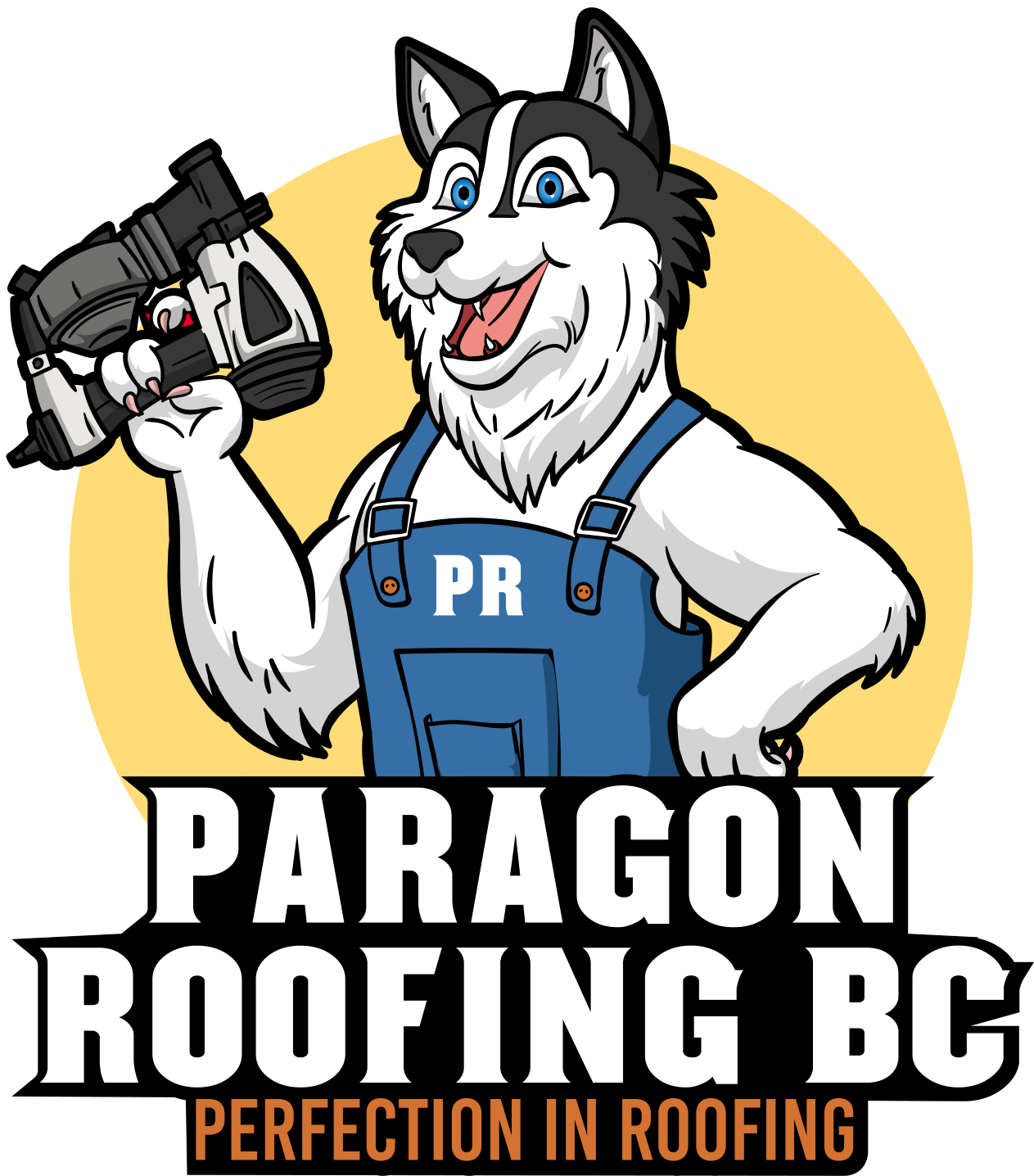
Experience The Paragon Roofing BC Difference
Perfection in roofing. Because we're different.
Your satisfaction is guaranteed. Throughout the whole process, from the initial onsite consult to the final roof install, our friendly and knowledgeable team members will work with you to maintain open communication.
Frequently Asked Questions.
Roofing is an investment into your property. Here are some FAQs to help navigate making that choice.
What are signs I need roof repairs?
Roof leaks cause stains on walls and ceilings which make them visually obvious. If your insulation is compromised, you’ll likely smell moist air that could be from water coming in through a leaky roof.
How long can I expect my roof repair or new roof to last?
A new roof will last longer than a repair or patch job. However, you might not need a completely new roof installed because some repairs are small enough to prevent larger issues from getting worse.
How much do roofing services cost?
All roofing projects are different. The scope of the roofing service will be unique to each home. If it’s a small repair or a full roof replacement, you’ll see much different bottom lines on the estimates. With Paragon Roofing BC, we always provide transparent pricing that you’ll be able to rely on.
Here's What Our Existing Clients Think.
Home and business owners we've served across the greater Vancouver area.
Our Google Reviews
Edit Google Reviews Widget
Vancouver Roofing FAQ – Answers to the Most Common Questions
- How long does a roof last in Vancouver’s coastal climate?
- What roofing material performs best in heavy rain?
- Do Vancouver homes need ice & water shield?
- How often should you get a roof inspection?
- When is the best time of year to replace a roof?
- Vancouver Roofing Overview
- Blog: Roof Lifespan in Vancouver
- How do I know if my Vancouver roof needs repair?
- Can you repair a leaking roof in the rain?
- What causes roof leaks in Vancouver’s wet climate?
- Roof Repair Vancouver
- Blog: Repair vs Replace in Vancouver
- How much does a roof replacement cost in Vancouver?
- How long does a roof replacement take?
- Do Vancouver roofs require full tear-off?
- Roof Replacement Vancouver
- Blog: Roof Replacement Cost in Vancouver
- Blog: Installation Timeframes
- What roofing materials work best in Vancouver rain?
- Is metal roofing good for Vancouver homes?
- Do asphalt shingles last long in the Lower Mainland?
- What is the most durable roof type for ocean exposure?
- Vancouver Roofing Materials
- Blog: Guide to Roofing Materials
- How does Vancouver’s rain affect roofing materials?
- Do metal roofs corrode near Vancouver’s ocean air?
- Why is moss so common on Vancouver roofs?
- Can roofing be done during heavy rain?
- Blog: Coastal Weather Impact
- Blog: Moss Control Vancouver
- How often should I get a roof inspection?
- What are early warning signs of roof failure?
- Should I clean my Vancouver roof yearly?
- Roof Inspections Vancouver
- Roof Maintenance Vancouver
- Blog: 12 Signs You Need an Inspection
- Is metal roofing too noisy during Vancouver rain?
- Does metal roofing rust in ocean air?
- Is metal more energy-efficient than shingles?
- Metal Roofing Vancouver
- Blog: Rust Near Ocean Air
- Blog: Noise in Vancouver Rain
- Does insurance cover roof leaks?
- What to do if your roof leaks during heavy rain?
- Do you offer emergency roofing services?
- Blog: Roofing Insurance Guide
- Roof Leak Repair Vancouver
Core Vancouver Roofing Hubs
- Paragon Roofing BC – Home
- Vancouver Roofing Overview
- All Vancouver Roofing Services
- Residential Roofing – Vancouver
- Commercial Roofing – Vancouver
- Strata & Multi-Family Roofing – Vancouver
- Roofing Materials – Vancouver
Key Vancouver Service Pages
- Roof Installation – Vancouver
- Roof Replacement – Vancouver
- Roof Repair – Vancouver
- Roof Maintenance – Vancouver
- Commercial Roof Installation – Vancouver
- Commercial Roof Repair & Maintenance – Vancouver
- Roof Ventilation – Vancouver
- Skylight Repair & Installation – Vancouver
- Chimney Repair & Flashing – Vancouver
Metal Roofing in Vancouver
- Metal Roof Ventilation & Condensation in Vancouver
- Metal Roof Fasteners vs Concealed Clips – Vancouver
- Metal Roof Warranty & Strata Rules – Vancouver
- Metal Roofing for Low-Slope Roofs in Vancouver
- Metal vs Asphalt in Vancouver Rain
- Metal Roof Temperature & Insulation – Vancouver
- Do Vancouver Roofs Need Ice & Water Shield?
- Standing Seam vs Metal Shingles – Vancouver
- Do Metal Roofs Rust Near Vancouver’s Ocean Air?
- Are Metal Roofs Noisy in Vancouver Rain & Wind?
- How Long Do Metal Roofs Last in Vancouver?
- Installing Metal Over Shingles in Vancouver
- Metal Roof Cost – Vancouver 2025 Guide
- Expert Insights on Metal Roofing in Vancouver
- Standing Seam Metal Roofing – Ultimate Vancouver Guide
Roofing Materials & Systems in Vancouver
- Ultimate Guide to Roofing Materials in Vancouver
- Practical Guide to Asphalt Shingles in Vancouver
- Roof Insulation in Vancouver – Everything You Need to Know
- Attic Insulation & Ventilation – Vancouver R-Values, Moisture & Mould
- Asphalt Shingles vs Metal in Rainy Vancouver
- Flat Roofs in Vancouver – Managing Rainwater & Drainage
- Converting a Flat Roof to Low-Slope – Vancouver
- Drainage on Commercial Flat Roofs – Vancouver
Vancouver Climate, Weather & Roof Maintenance
- Flat Roofing in Vancouver’s Coastal Climate
- Common Vancouver Roof Maintenance Mistakes
- Impact of Coastal Winds on Vancouver Roofs
- Handling Roofing During Vancouver’s Rainy Season
- Moss Growth on Vancouver Roofs – Causes & Control
- How Coastal Weather Affects Vancouver Roofing
- Preparing Vancouver Roofs for Winter & Rainy Seasons
- Why Roof Ventilation Is Non-Negotiable in Vancouver
- Maximizing the Lifespan of Vancouver Roofs
- How Long Do Roofs Last in Vancouver?
Cost, Financing & Roof Replacement Decisions – Vancouver
- How Much Does a Roof Replacement Cost in Vancouver? (2025)
- No-Nonsense Roof Replacement Cost Guide – Vancouver
- Roof Replacement vs Roof Repair – Making the Right Choice
- When to Replace Your Roof in Vancouver
- Timeframe for Roof Installation Projects – Vancouver
- Roofing Costs & Financing Options – Vancouver
- Roofing Insurance & Claims – Vancouver
Choosing a Vancouver Roofer & Why Paragon
- Choosing a Roofing Contractor in Vancouver
- Why Choose Paragon Among Vancouver Roofing Companies
- Raising the Bar in Roofing Vancouver, BC
- Answering Roofing Questions & Debunking Myths – Vancouver
Installation, Repair & General Vancouver Roofing Guides
- All You Need to Know – Roof Installation & Replacement in Vancouver
- When to Replace Your Roof in Vancouver
- Preparing Your Vancouver Roof for Winter & Rain
- (Cross-regional) How Roofing Enhances Home Value – Paragon Perspective
Energy Savings & Eco Roofing in Vancouver
- Maximizing Energy Savings Through Roofing in Vancouver
- Eco-Friendly Roofing Options in Vancouver – Honest Take
Metro Vancouver & North Shore Related Guides
We look forward to helping you.
For all your roofing needs, give us a call, text, or email. 604-358-3436
Paragon Res Roof #3
We will get back to you as soon as possible.
Please try again later.
